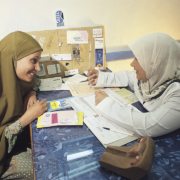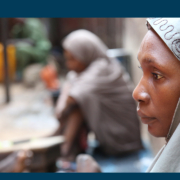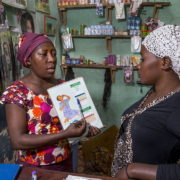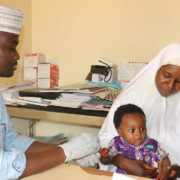Building Trust and Empathy Around COVID-19 in Nigeria: What Have We Learned?
Photo by: Edoziem Chisom Valentine, Breakthrough ACTION-Nigeria
Written by: Lisa Mwaikambo, Senior Program Officer II, Breakthrough ACTION, Dr. Joseph Edor, Senior Program Officer II, Breakthrough ACTION, Mwikali Kioko, Senior Program Officer II, Breakthrough ACTION, Dr. Olayinka Umar-Farouk, Deputy Project Director for Risk Communication, Breakthrough ACTION
Breakthrough ACTION supports the Government of Nigeria in creating an enabling environment for preparedness, response, and recovery from emerging pandemic threats and infectious disease outbreaks. Working with and through health care workers (HCWs) during the COVID-19 response efforts has been key to this support. Research shows:
- HCWs are trusted messengers for social and behavior change (SBC) interventions. In fact, results from the U.S. Centers for Disease Control and Prevention/Sydani Vaccine Hesitancy Study in Nigeria showed that 83% of participants said they would seek advice from a HCW in the decision to get vaccinated for COVID-19.
- HCWs were more likely to be vaccinated than the general population for COVID-19. However, many remained vaccine hesitant. This was largely due to a lack of confidence in the vaccines, followed by a lack of trust in government/public figures, fear of adverse effects, constraints to access, and low perception of risk of disease.
- HCWs reported that they lacked sufficient information on COVID-19 and COVID-19 vaccines and required more information.
In response to this demonstrated need, Breakthrough ACTION, in collaboration with partners in Nigeria, developed the “Building Trust and Empathy Around COVID-19” training curriculum, which aims to not only build the skills of HCWs in providing empathetic care but also support them in navigating their own self-care to avoid burnout during an emergency. The training combines an in-person component along with virtual coaching support and reference materials, such as the implementation plan, training participant’s booklet, awareness cards, posters, and learning videos.
To create a client-centered care movement built upon trust and empathy for clients and HCWs, Breakthrough ACTION has paused at several points to take stock of what is working well and what can be improved in its approach. This has led to an iterative process of curriculum enhancements and a wealth of insights that it thinks would help others to adapt and replicate the approach.
Among the most critical lessons learned are the following:
- HCWs should be approached as an audience, not just a communication channel. Many HCWs demonstrated a lack of empathy with their colleagues due to their own negative personal experiences when they were clients interacting with the health system. Therefore, the training was well-received because of its emphasis on empathy, self-care, and the well-being of HCWs. It served as a catalyst for conflict resolution among facility staff.
With this training, I have now made up my mind to take the COVID-19 vaccine because I have seen that the benefits is more than the side effects. Conflict management is another area that I really benefited from and hope to apply it in my everyday life.
Assistant Director of Nursing Services, Federal Medical Centre, Jabi
The training is very educational, I can now convince my family on the need to take the COVID-19 vaccine and I know it will be a positive response. I also learned how to cope with stress and fatigue and understood the concept of empathy.”
Chief Nursing Officer, Federal Medical Centre, Jabi
- The role of advocacy in this intervention cannot be underplayed. Advocacy was necessary at the highest levels, including with leadership at the facility and public health associations, to get their buy-in with the step-down training approach. The step-down approach requires trained staff at the state level of the health system to serve as facilitators of the step-down trainings at the facility level. The project discussed this step-down training approach at the beginning of advocacy engagements as an expectation for participation in the training. This helped to ensure broader coverage, shared expenses, and greater ownership of the Building Trust and Empathy training. Getting the buy-in of most public facilities was relatively easy. However, this was not the case when engaging faith-based and private facilities. They required more frequent and robust advocacy visits to get and maintain their buy-in throughout the lifespan of the intervention.
- Conducting the trainings in batches was strategic. Although the training content was considered timely, high-volume secondary and tertiary facilities across all the selected states were extremely busy because of the COVID-19 pandemic. Facility management was initially reluctant and submitted limited numbers of HCWs to participate. As a result, groups of HCWs were organized in batches for the training. After the first batch of training, there was usually a call for training more batches of HCWs.
- Training HCWs at the facilities in which they work has advantages and disadvantages. An advantage is the buy-in from facility leadership and, therefore, the perceived importance of the training as a result. In addition, having a captured audience facilitates training as many HCWs as possible across different units/departments and supporting a level of organizational normative change. Since the training is conducted in the facility, services are not significantly disrupted either. However, HCW participants are often distracted and will need to come and go at times to respond to urgent matters.
- Operationalizing this step-down training approach necessitated considering and planning for incentives. Breakthrough ACTION provided lunch to participants at facilities, while the facilities provided the training space and support for their staff to participate by identifying who would. HCWs appreciated certificates of participation. In addition, Breakthrough ACTION partnered with an accredited e-learning platform to transform the in-person into a two- to three-hour-long e-learning course, which is now available for two continuing professional development credits for HCWs on the World Continuing Education Alliance (WCEA’s) platform. Finally, the project benefited from positioning the step-down facilitation role as a recognition of HCW champions and public service and something that could be highlighted on HCWs’ resumes for future opportunities.
- The training approach and content were developed in a highly participatory and iterative manner. Breakthrough ACTION worked in close partnership with government agencies, service delivery partners, and potential beneficiaries from pilot facilities and members of the Network of People Living With HIV/AIDS in Nigeria. This ensured that the content met the needs of the target audience while also ensuring ownership of the approach by the government so it could easily implement the training along with service delivery partners with or without Breakthrough ACTION’s involvement. The modules build upon global and local evidence on the COVID-19 response and complement the Nigeria National Interpersonal Communication and Counseling manual.
- A variety of reinforcement materials ensures success. Research shows that a one-off training is necessary but not sufficient. As a result, Breakthrough ACTION designed its Building Trust and Empathy collaborative learning approach, which combines in-person training with virtual coaching support via WhatsApp Groups and supplemental reference materials. Although the WhatsApp Group for the coaches or trained facilitators that took part in the national training of trainers was very active after the training, the WhatsApp Groups of HCWs that took part in the step-down facility-level trainings never really took off, even though Breakthrough ACTION developed a posting schedule with different content to spark discussions. This highlights the importance of planning for other reinforcement materials, such as posters, job aids, awareness cards, and learning videos, which facility-level participants better received. It also highlights an area for future exploration. Are there online platforms that HCWs are more likely to use for peer-to-peer learning and coaching? Or could we leverage existing face-to-face meetings that HCWs already attend, like staff meetings and grand rounds, to facilitate this type of exchange and support? These are questions that Breakthrough ACTION is continuing to explore.
The Building Trust and Empathy collaborative learning approach started as an intervention to increase the uptake of COVID-19 testing and vaccination. However, the project quickly found the content on interpersonal communication, empathy, self-care/well-being, and evidence-based communication strategies can be applied—and is being applied—more generally to address broader health care outcomes.
This training is timely and of utmost importance in improving the quality of health services we provide in general and not only around COVID-19.
Chief Medical Director, Federal Medical Centre, Jabi

 Breakthrough ACTION
Breakthrough ACTION Center for Communication Programs/Photoshare
Center for Communication Programs/Photoshare
 Jonathan Torgovnik/Getty Images/Images of Empowerment
Jonathan Torgovnik/Getty Images/Images of Empowerment
 WHO
WHO Breakthrough ACTION
Breakthrough ACTION